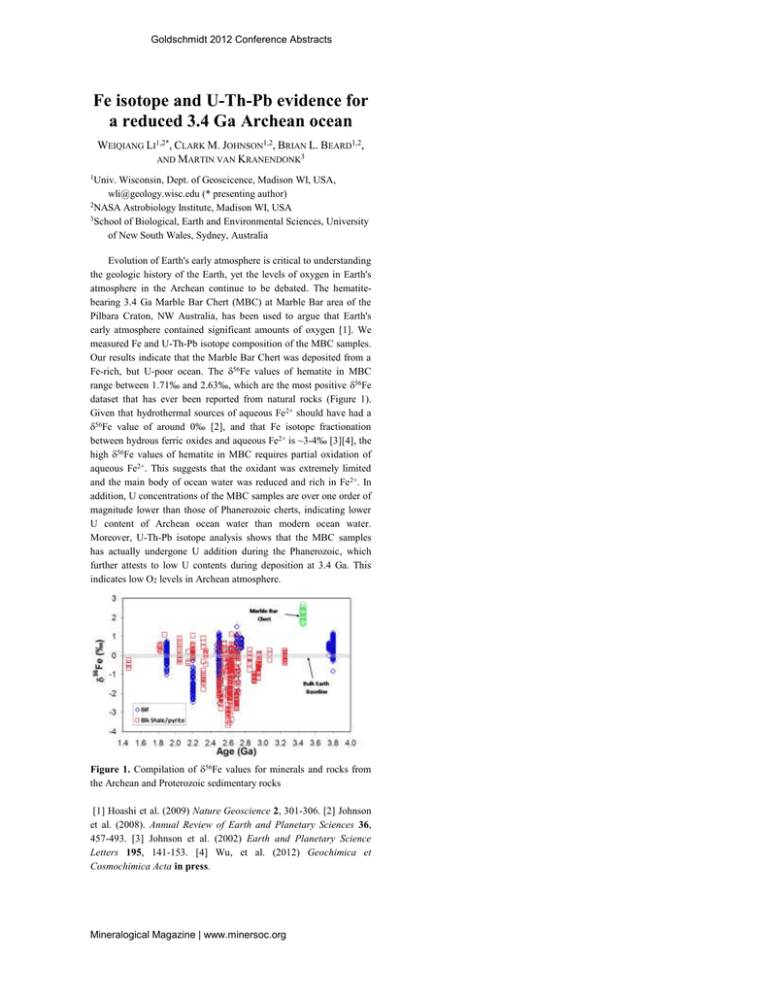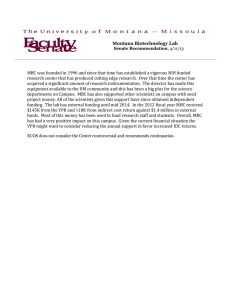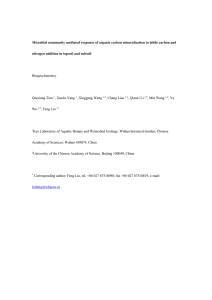Fe isotope and U-Th-Pb evidence for W
advertisement

Goldschmidt 2012 Conference Abstracts Fe isotope and U-Th-Pb evidence for a reduced 3.4 Ga Archean ocean WEIQIANG LI1,2*, CLARK M. JOHNSON1,2, BRIAN L. BEARD1,2, AND MARTIN VAN KRANENDONK3 1Univ. Wisconsin, Dept. of Geoscicence, Madison WI, USA, wli@geology.wisc.edu (* presenting author) 2NASA Astrobiology Institute, Madison WI, USA 3School of Biological, Earth and Environmental Sciences, University of New South Wales, Sydney, Australia Evolution of Earth's early atmosphere is critical to understanding the geologic history of the Earth, yet the levels of oxygen in Earth's atmosphere in the Archean continue to be debated. The hematitebearing 3.4 Ga Marble Bar Chert (MBC) at Marble Bar area of the Pilbara Craton, NW Australia, has been used to argue that Earth's early atmosphere contained significant amounts of oxygen [1]. We measured Fe and U-Th-Pb isotope composition of the MBC samples. Our results indicate that the Marble Bar Chert was deposited from a Fe-rich, but U-poor ocean. The 56Fe values of hematite in MBC range between 1.71‰ and 2.63‰, which are the most positive 56Fe dataset that has ever been reported from natural rocks (Figure 1). Given that hydrothermal sources of aqueous Fe2+ should have had a 56Fe value of around 0‰ [2], and that Fe isotope fractionation between hydrous ferric oxides and aqueous Fe2+ is ~3-4‰ [3][4], the high 56Fe values of hematite in MBC requires partial oxidation of aqueous Fe2+. This suggests that the oxidant was extremely limited and the main body of ocean water was reduced and rich in Fe2+. In addition, U concentrations of the MBC samples are over one order of magnitude lower than those of Phanerozoic cherts, indicating lower U content of Archean ocean water than modern ocean water. Moreover, U-Th-Pb isotope analysis shows that the MBC samples has actually undergone U addition during the Phanerozoic, which further attests to low U contents during deposition at 3.4 Ga. This indicates low O2 levels in Archean atmosphere. Figure 1. Compilation of 56Fe values for minerals and rocks from the Archean and Proterozoic sedimentary rocks [1] Hoashi et al. (2009) Nature Geoscience 2, 301-306. [2] Johnson et al. (2008). Annual Review of Earth and Planetary Sciences 36, 457-493. [3] Johnson et al. (2002) Earth and Planetary Science Letters 195, 141-153. [4] Wu, et al. (2012) Geochimica et Cosmochimica Acta in press. Mineralogical Magazine | www.minersoc.org


